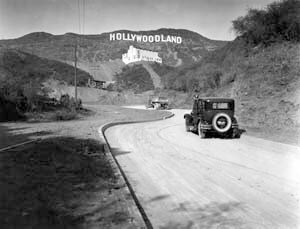M. H. Sherman, Arnold Haskell, and the Hollywood Sign

Paul Wormser, Library Director
What does the Hollywood sign have to do with Sherman Library & Gardens? Quite a lot, as it turns out. The Hollywood sign started out as the Hollywoodland sign, an advertising gimmick designed to attract buyers to a new luxury housing subdivision: Hollywoodland. Dubbed “the supreme achievement in community building,” the subdivision land was owned by Moses H. Sherman, namesake of Sherman Library & Gardens. In 1922, Sherman put together the Hollywoodland syndicate (as business partnerships were often called then) which included his business partner and brother-in-law Eli P. Clark, Los Angeles Times publisher Harry Chandler, and developers Tracy Shoults and Sydney H. Woodruff. The Hollywoodland sign cost the syndicate $23,501.32. While the sign proved popular, sales of lots in Hollywoodland were lackluster. The cost of building in the Hollywood hills was too high for many and the Great Depression ended any hope of making money from the deal. In 1933, the syndicate dissolved and the unsold land, including the Hollywoodland sign, became property of the M. H. Sherman Company.
Increasingly in disrepair, maintenance of the sign became a problem for Arnold Haskell, future founder of Sherman Library & Gardens – and after Sherman’s death in 1932 – president of M. H. Sherman Company. The sign was expensive to maintain, but it was not generating any revenues. On September 19, 1936 the left most “O” in the sign fell down. Two days later Haskell had a report detailing the structural problems of the sign – letter by letter. But the cost was too high considering how few lots were selling. By 1938 the condition had worsened to the extent that Hollywood Citizen-News published a letter from a reader who wrote, “I wish that during the Easter vacation some of the public-spirited Hollywood High School students would get [the] necessary equipment and go up to the ‘HOLLYWOODLAND’ sign on Hollywood Mountain and replace two or three of the letters that have blown down.” In early 1939, the company bowed to public pressure and repaired the sign at a cost of $2,177.43. But the company continued to look for ways to rid itself of the sign – even negotiating, but never signing – a deal with the producers of the film Wilson to use the sign’s superstructure to mount advertising for the movie’s opening, in return for removing the entire sign afterward. The solution finally came in the form of a gift. In 1945, the M. H. Sherman Company donated 455 acres, including the sign, to the Los Angeles Department of Parks and Recreation, as an addition to Griffith Park. Later the Hollywood Chamber of Commerce paid to repair the sign and remove the “LAND” portion.


